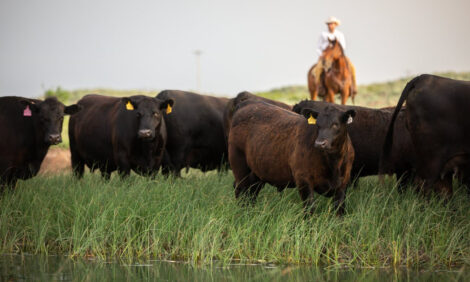



2011 Trade Forecast Update: Beef Remains Stable
Beef production is virtually unchanged since the last forecast in October 2010 and tight supplies and high prices continue to constrain significant trade expansion, according to the latest Livestock and Poultry World Markets and Trade report from USDA Foreign Agricultural Service.Amidst this environment, the revised trade forecast calls for a shift in gains expected among exporters as supplies, prices and exchange rates impact competitiveness particularly in Middle East and Southeast Asia markets. Increases in shipments are now expected to be largely captured by up-and-coming supplier India rather than Brazil, the world’s leading exporter. Demand in many key markets is largely dependent on the pace of economic recovery.
Record global pork production is largely a function of efficiency gains in China, and higher slaughter weights in the EU, which are expected to more than offset the foot-and-mouth disease (FMD) related drop in South Korea. Expanded world trade is driven by strong demand from South Korea, China, and the Ukraine.
Broilermeat production is forecast to expand on stronger demand and tight supplies of beef and pork in most major producing countries. World trade remains virtually unchanged. Russia’s December announcement of a 38 per cent decline in the tariff rate quota (TRQ) volume to 375,000 metric tons resulted in a significant downward revision to its import forecast. Chinese imports are forecast lower as reduced US shipments (as a result of market access issues) more than offsets higher shipments from South America. Brazilian and US exports are revised lower, offsetting larger exports from the EU and China on strong demand from Asian and African markets.
Beef and Veal: 2011 Revised Forecast Overview
Tight Supplies to Persist as World Production Virtually Unchanged
Australian production is revised slightly upward as improved pasture conditions generate heavier weights.
Strong US fed cattle prices and increased feeder cattle imports from Mexico are expected to drive slaughter higher than previously forecast, spurring increased production.
Argentina is forecast lower due to heavier weights not offsetting a downward revision in slaughter. Conditions encourage producers to herd rebuilding.
The historical Russian cattle and beef/veal data series is revised.
Indian Exports Forecast to Escalate, Constraining Brazilian Expansion
Exports
Strong export growth by India is expected to continue. This expansion, paired with a significant upward revision in the 2010 forecast, generates a substantially higher 2011 forecast. Comparatively low prices, a beneficial exchange rate, ample supplies and robust Southeast Asian and Middle East demand are spurring shipments. In addition to benefiting from increased market access and growing demand in key markets, India is better able to compete with Brazil due to its price competitiveness. As a result, India is expected to capture some market share from Brazil, the world’s leading exporter. Therefore, growth in Brazilian exports is revised significantly downward.
The United States is forecast higher on a competitive dollar, strong Asian demand, and tight Oceania supplies. Improved Asian market access spurs an increase for Mexico. The EU is revised upward on ample supplies enabling shipments to Russia and the shortterm sales to Turkey.
Lower than expected production reduces Argentina, which are forecast less than half of the volume achieved just two years ago. Despite ample supplies, high prices cause Uruguay to struggle to expand shipments, generating a downward revision.
Imports
A downward revision in the United States is driven by increased production, constrained consumption as economic recovery is slower than expected and a weaker dollar a relatively high-priced Oceania product hinders imports. Similarly, sluggish economic recovery and elevated prices hinder Mexican and EU imports. The EU is also negatively impacted by further reductions in Argentine exportable supplies.
Korea is revised upward on lower production, reduced pork supplies and rising consumer confidence in US beef.
Pork: 2011 Revised Forecast Overview
World Production Slightly Higher
Chinese production is raised slightly from October’s forecast, as high pork prices and stronger demand encourage expansion by modern, more efficient producers.
The EU is revised upward in line with higher than expected slaughter and weights. Restructuring in the hog industry is expected to accelerate, as the most inefficient farms and some backyard production leave the industry.
Historical revisions were made to the Russian swine and pork data. High feed prices and limited feed availability in late 2010 constrained previously forecast expansion.
South Korea is reduced by one third (the lowest level in nearly twenty years) as a result of the worst FMD outbreak in the country’s history. The culling of 30 per cent of the swine herd, combined with the 2 to 3 month waiting period before restocking FMDaffected farms, will temporarily reduce the pig crop.
The US forecast is raised slightly due to higher expected slaughter and heavier weights.
World Imports Raised Mostly on South Korea
Shortages in South Korean domestic pork supplies are expected to be partially offset by a nearly 50 per cent jump in expected imports. To facilitate those imports and help curb rising prices, the Korean government created a special zero duty tariff-rate-quota (TRQ) for frozen pork bellies and other cuts. Even with larger imports however, pork consumption is expected to fall, as high prices cause consumers to shift to other meat proteins such as fish, poultry, and imported red meats.
China is raised as robust demand outpaces modest production gains.
Ukraine is revised upward in response to stronger demand.
World Exports Up as the EU and the United States Capture Rising Asian Demand
EU is forecast significantly higher with strong demand from Asia and Russia. The EU will likely fill much of the Korean zero duty TRQ for frozen pork bellies, while expanded pork shipments to Russia are expected in place of live hogs for slaughter.
The United States’ forecast is unchanged although stronger shipments are expected in the first half of the year due to strong demand from South Korea and China. Along with the EU, US pork is expected to account for a portion of the Korean zero duty TRQ for pork cuts given its readily available supplies and strong price competitiveness.
Broiler Meat: 2011 Revised Forecast Overview
World Production Expands
Russia’s historical data series is revised.
Forecasts for China, Brazil, and the EU are revised upward on rising domestic demand. In China, strong demand has stimulated production enabling producers to raise prices, which helps offset higher feed costs. In Brazil, growing disposable incomes, high beef prices, and strong exports support production expansion. The EU is revised slightly higher to meet slowly growing domestic demand.
The United States forecast is revised higher on heavier bird weights.
Argentina’s production is revised down on slower than anticipated industry expansion.
World Trade Virtually Unchanged
Imports
The December announcement of a reduction in Russia’s TRQ resulted in a significant downward revision in Russia’s expected imports.
Mexico and the Philippines forecasts are raised on strong demand for mechanically deboned meat.
Some African markets are revised higher on strong demand, e.g. Angola, Benin, and South Africa.
The forecast for Saudi Arabia is increased as production gains are unable to keep pace with growing demand.
Japan is raised on increased demand and short-term disruption in production due to the tsunami and earthquake.
EU is revised lower on more stringent regulations.
China’s forecast is revised lower on continued antidumping and countervailing duties on US product.
Exports
Greater exports by the EU, China, and Thailand are the result of higher demand from some Asian markets, particularly Japan and Viet Nam. EU shipments are also bolstered by demand from African markets.
Exports from Brazil and Argentina are revised downward, but still remain at record levels.
US exports are revised lower primarily on the reduced TRQ in Russia and market access issues in China.
Further Reading
| - | You can view the full report by clicking here. |
April 2011


